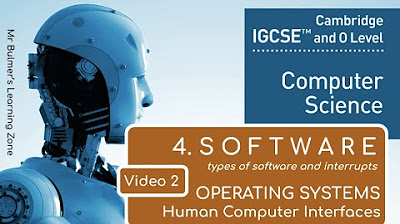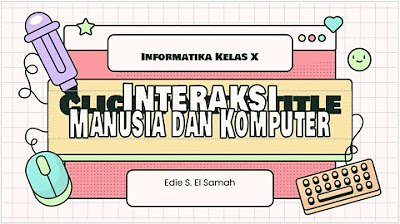Chapter 7: Interfaces
Summary
TLDRIn this video, Chapter 7 of 'Interaction Design: Beyond Human-Computer Interaction' explores various types of interfaces, including command line, graphical user, multimedia, and mobile interfaces. It discusses how interfaces like voice, touch, and brain-computer interaction allow users to engage with technology in innovative ways. The video highlights the significance of emerging technologies like augmented reality, virtual reality, and wearable devices. Practical examples, such as appliances with digital interfaces and robots, demonstrate how these interfaces are integrated into everyday life. This overview offers insight into how human-computer interaction is evolving in response to new technological advancements.
Takeaways
- 😀 The video introduces different types of interfaces from Chapter 7 of *Interaction Design: Beyond Human-Computer Interaction (5th Edition)*.
- 😀 Command Line Interfaces (CLI) were one of the first ways to interact with computers through typed commands.
- 😀 Graphical User Interfaces (GUI) introduced visual elements like windows and folders, making interaction more intuitive.
- 😀 Multimedia interfaces use multiple forms of media (visual, auditory, written) to provide diverse ways of accessing information.
- 😀 Web design has evolved over time, with significant changes in user interface (UI) development visible in the progression of web technologies.
- 😀 Mobile devices, such as smartphones and laptops, are pervasive, and wearables like fitness trackers provide health-related data.
- 😀 Appliances with digital interfaces are common, with examples like coffee machines that have buttons with different behaviors.
- 😀 Pen-based devices, touchscreens, and tangible interfaces enable intuitive interactions with digital content and physical objects.
- 😀 Gestural interfaces, like Leap Motion, allow users to control devices through hand movements, but are culturally variable.
- 😀 Voice interfaces (e.g., Google Assistant) let users control devices using spoken commands.
- 😀 Haptic interfaces provide tactile feedback, such as vibrations, to inform users about interactions or adjustments.
- 😀 Brain-computer interaction (BCI) allows control of devices through brain signals, as demonstrated by a woman manipulating a bottle using her mind.
- 😀 Robots and drones are examples of devices that can perform tasks autonomously or interact with humans in various settings.
- 😀 Multimodal interfaces combine different interaction methods (e.g., voice and gesture), enhancing usability and flexibility.
- 😀 Augmented Reality (AR) overlays digital content on the real world, while Virtual Reality (VR) immerses users in a fully virtual environment.
Q & A
What is the primary focus of Chapter 7 in the book 'Interaction Design: Beyond Human-Computer Interaction'?
-Chapter 7 focuses on different types of interfaces, covering 20 varieties ranging from command line and graphical user interfaces to more advanced ones like brain-computer interaction and smart devices.
What are some examples of multimedia interfaces?
-Multimedia interfaces involve presenting information in more than one format, such as visual, auditory, or written content, which allows for more accessible and engaging ways to interact with information.
How did graphical user interfaces (GUIs) evolve from command line interfaces?
-Command line interfaces required users to type specific commands, while graphical user interfaces (GUIs) introduced visual elements like windows, folders, and icons, making interaction more intuitive and user-friendly.
What is the significance of mobile devices in modern human-computer interaction?
-Mobile devices, such as smartphones, tablets, and wearables, are now ubiquitous, providing continuous access to digital interfaces and facilitating constant interaction with technology in daily life.
What is an example of how appliances are incorporating digital interfaces?
-Appliances like coffee machines are incorporating digital interfaces where users may face uncertainty in how to interact with the device, such as whether to press a button momentarily or continuously for certain functions.
What are tangible interfaces, and how do they work?
-Tangible interfaces allow users to physically interact with devices, like the 'Dišimo' machine, which responds to touch and breath synchronization by making sounds or triggering movements.
What is the role of haptic feedback in human-computer interaction?
-Haptic feedback provides tactile sensations to users, such as vibrations when adjusting volume on a device, helping users interact more intuitively with the system by providing physical confirmation of actions.
How do brain-computer interfaces work, and what example was provided?
-Brain-computer interfaces allow users to control devices using their brain signals. An example provided was a woman manipulating a bottle to drink water using only her brain activity.
What are multimodal interfaces, and how do they combine different interaction methods?
-Multimodal interfaces combine multiple interaction methods, such as voice and gesture recognition, to allow users to control systems in more flexible and dynamic ways.
What is the difference between augmented reality (AR) and virtual reality (VR)?
-Augmented reality (AR) overlays digital information onto the real world, enhancing the user's perception of their surroundings, while virtual reality (VR) immerses users entirely in a virtual environment, disconnecting them from the physical world.
Outlines

Dieser Bereich ist nur für Premium-Benutzer verfügbar. Bitte führen Sie ein Upgrade durch, um auf diesen Abschnitt zuzugreifen.
Upgrade durchführenMindmap

Dieser Bereich ist nur für Premium-Benutzer verfügbar. Bitte führen Sie ein Upgrade durch, um auf diesen Abschnitt zuzugreifen.
Upgrade durchführenKeywords

Dieser Bereich ist nur für Premium-Benutzer verfügbar. Bitte führen Sie ein Upgrade durch, um auf diesen Abschnitt zuzugreifen.
Upgrade durchführenHighlights

Dieser Bereich ist nur für Premium-Benutzer verfügbar. Bitte führen Sie ein Upgrade durch, um auf diesen Abschnitt zuzugreifen.
Upgrade durchführenTranscripts

Dieser Bereich ist nur für Premium-Benutzer verfügbar. Bitte führen Sie ein Upgrade durch, um auf diesen Abschnitt zuzugreifen.
Upgrade durchführenWeitere ähnliche Videos ansehen

HCI 3.5 Part 1: Interaction Styles (Command Line, Natural Language, Menu, Ques/Ans & Queries) in HCI

Pengertian dan Jenis User Interface | Analisis dan Desain Sistem

Interface Style - command line interface

IGCSE Computer Science 2023-25 - SOFTWARE: Video 2 - THE OPERATING SYSTEM

Interaksi Manusia dan Komputer - Informatika Kelas X

38. OCR GCSE (J277) 1.5 The purpose of operating systems
5.0 / 5 (0 votes)
